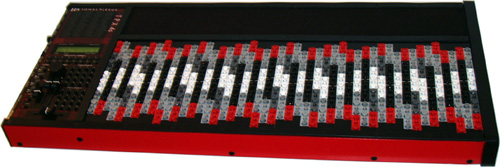



April 21, 2010
One of the first shipping Tonal Plexus keyboards I built was purchased by the Berklee College of Music in Boston, MA, where it is now used by guitarist David Fiuczynski and his students. I recently made some upgrades and improvements to this instrument. The upgrades included new firmware for the chips, new red front and back pieces for the body, countersinking the screws on the finishing strips, and new top panels for the keys.

New instruments come with all these improvements and refinements. The early keyboards like the one purchased by Berklee had some issues with the top panels, around the keys themselves, because the material was thin and flexible, and on some instruments this caused some warping of the surface; this was one of those instruments that had a problem. I show the former panel in the video, and you can see how flexible it is. Panels on currently shipping keyboards are thick and rigid, so warping is not a problem anymore. The firmware upgrade improves fader response and adds some useful options for how MIDI banks and patches are handled in presets. The other improvements are basically cosmetic, although the countersunk screws do change a minor tactile element of the design.
If you own one of the early Tonal Plexus keyboards and you would like to have these upgrades and improvements, please contact me to discuss it; I would be happy to give your instrument an overhaul and I know you would appreciate the difference.After doing the work on Berklee's keyboard, before shipping it back, I recorded this little video in which I point out the improvements, and then demonstrate something interesting about dominant 7th chords in Just Intonation.
Dominant 7th chords contain a diminished 5th between the 3rd and 7th, often called a tritone, although tritones are, strictly speaking, always augmented 4ths, not diminished 5ths (tritone = 3 tones = 3 whole tones in a row e.g. C to D to E to F# = C : F# = augmented 4th). The misnomer is indicative of the way pitches are named enharmonically in 12ET, where for example F# and Gb are the same pitch. In 12ET, two dominant chords can share the same pitches between their 3rds and 7ths, swapping roles of those pitches between the chords, because an augmented 4th and a diminished 5th use the same exact pitches. This can't happen in Just Intonation. In Just Intonation, a diminished 5th will never be an augmented 4th. This video shows how in JI either the 3rd or 7th can be used as a common tone, but not both. One or the other common tones can be kept in a dominant 7th chord whose root is either an augmented fourth or a diminished fifth away, since those intervals are not the same in Just Intonation. Make sense?
Note: the captions in this video introduced blips into the audio for some reason and I couldn't fix it; sorry about that!
[ Showing 1 entry | Next entry | Show all entries ]